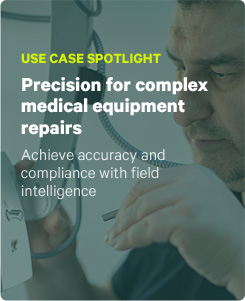
Safety in the field is about more than checking boxes on a form to pass compliance checks. It’s about keeping your team safe. That’s why it’s important to take preventative action towards a safer job site and preventing accidents before they happen. There are many safety workflow trends that allow you to consider factors that need to be addressed when arranging preventative action, and a rich data system is invaluable to ensuring your team is safe.
1. Age of equipment
Whether you’re discussing a table saw on a construction site, a CNC machine on a manufacturing warehouse floor, or an 18-wheeler driving coast to coast, equipment breaks down with age. The older a piece of equipment, the more likely it is to cause injury if left unmaintained.
2. Frequency of equipment use
The more you use a piece of equipment, the more worn down it will become. If a machine is being used once every few months, weekly maintenance might not be an issue. If it’s being used every day, however, wear and tear can cause safety concerns that need frequent checkups.
3. Job-appropriate training
With rotating personnel and turnover rates, it’s important to keep track of who has what training. Some accident prevention might seem intuitive or common sense, but it’s often the case that new employees just go with the flow: they second guess themselves rather than reporting something that they think is unsafe. Task-appropriate training helps mitigate the risks associated with employees not recognizing when they’re in an unsafe situation. Being consistent in safety training also shows employees you’re committed to their safety, and reassures them management is committed to safety, and that they won’t get in trouble for shutting down a site due to safety concerns.
4. Job-appropriate PPE
One of the biggest financial burdens related to safety is personal protective equipment (PPE). PPE refers to gear meant to protect the wearer from environmental hazards, from falls to corrosive materials. Gloves, goggles, reparatory masks, and safety harnesses should be used in every situation necessary, but they’re no use if they’re not in good condition or the right size. A 6’4” man will have different size and weight requirements than a 5’2” woman for fall protection, for example. Keeping track of what everyone needs and preparing for a job based on that information is a crucial part of prevention, and is easy if you’ve got the right information on file.
5. Effective safety inspections/risk assessments
Safety inspections aren’t very useful if the data they collect is incomplete or incorrect. This problem often arises when questions focus on subjective inquiries – “Is this situation dangerous?” – rather than objective questions like, “How high is the platform the worker is standing on?” The former leaves room for technician safety to fall through the cracks caused by a busy job site, or a tired technician. The latter, however, is based on facts, and measures off an existing standard for safety.
If that all seems daunting, don’t worry. There are lots of services that are designed with this exact situation in mind. At the end of the day, what you want is to keep your people safe, and your site running smoothly, so be sure to invest your time and money in services and equipment meant to do just that.
If you want to learn more about which safety workflow trends can make your site safer, go ahead and check out our webinar, Reaching Your Safety Goals with Mobility.




